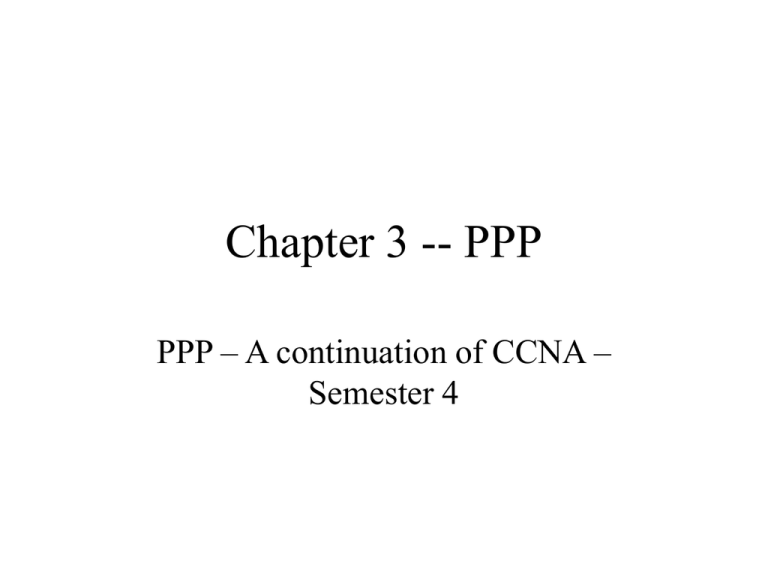Chapter 3 -
advertisement

Chapter 3 -- PPP PPP – A continuation of CCNA – Semester 4 DataLink (Layer 2) TCP/IP Protocols • SLIP - SLIP is a standard protocol for pointto-point serial connections, using TCP/IP. • SLIP was a predecessor of PPP. • PPP - PPP provides router-to-router and host-to-network connections over synchronousand asynchronous circuits, which can be either dialup or leased lines. PPP Supports • Protocols – TCP/IP, AppleTalk, IPX • Essential features such as dynamic address allocation, PAP authentication, CHAP authentication, and Multilink PPP HDLC • High-Level Data Link Control (HDLC) is the default encapsulation for ISDN and serial interfaces on a Cisco router. Although HDLC is a default encapsulation, Cisco's HDLC is not necessarily compatible with other vendors' HDLC implementations • PPP is a standard protocol – can be used with any vendor equipment PPP Specifications • It is a standard – operates at OSI Layer 2 • Encapsulates Layer 3 datagrams with a specialized frame. • PPP defines the Link Control Protocol (LCP) • Once the LCP establishes the Layer 2 connection, the Network Control Protocol (NCP) takes over– frame includes protocol field – Each Layer 3 protocol has its own NCP. For example, IP's NCP is IPCP; IPX's NCP is IPXCP, and Appletalk's NCP is ATALKCP Code • RTA(config)#interface async 2 • RTA(config-if)#encapsulation ppp Remote Connections • Exec – Can dial in and take control of command line • Telnet • Access resources – network access – Can access printers, servers, etc. • PPP encapulation via asynchronous dialup connection Commands • • • • • RTA(config)#interface async 1 RTA(config-if)#encapsulation ppp RTA(config-if)#async mode interactive RTA(config)#line 1 RTA(config-line)#autoselect ppp during-login – Will eliminate possibility of Exec session • Router(config-if)#async mode dedicated – Will ensure PPP runs on specified line Programming Interface • RTA(config)#interface async1 • RTA(config-if)#ip address10.1.1.1 255.255.255.0 or • RTA(config-if)#ip unnumbered lo0 192.16.1.1 • RTA(config-if)#peer default ip address 10.1.1.1 – Assigns an address (usually host on same subnet) to the dial-in unit or • RTA(config-if)#peer default ip address pool NAME – Requires global command # ip local pool pool-name starting-address end-address. LCP Configuration Options • Authentication – CHAP or PAP • Callback – Billing consolidation • Compression – Reduces size of frame - Stacker, Predictor, and Microsoft Point to Point Compression (MPPC) • Multilink PPP – load balancing functionality over multiple WAN links Authentication Programming • Router(config)#username Romeo password Juliet • Router(config-if)#encapsulation ppp • Router(config-if)#ppp authentication pap • Router(config-if)#ppp pap sent-username GIN password RUMMY – Name and password are case sensitive • Dialer-map command tells each router what to do (suggest it be used) – see 3.2.2 Configuring CHAP • • • • Router(config-if)#encapsulation ppp Router(config-if)#ppp authentication chap Router(config-if)#ppp chap hostname GIN Router(config-if)#ppp chap password RUMMY – Remember that you will also have to configure a local username/password database, or point the router to the TACACS+ or RADIUS server that has that information. – Router(config-if)#ppp authentication pap chap Callback • provides a client/server relationshipbetween the endpoints of a point-to-point connection • can be used to control access and toll costs between hosts • the calling router (the callback client) pases authentication information to the remote router (the callback server) • for PPP callback server disconnects, and then places a return call • Both routers on a point-to-point link must be configured for PPP callback – server/client Configuration for Callback • Server(config)#username Client password itsasecret • Server(config)#map-class dialer DIALBACK • Server(config-map-class)#dialer callback-server username • Server(config-map-class)#exit • Server(config)#interface async 1 • Server(config-if)#ppp callback accept • Server(config-if)#dialer map ip 10.1.1.2 name Client class DIALBACK modem-script hayes56k broadcast 5556002 Client Configuration • • • • • • • Client(config)#interface async 1 Client(config-if)#encapsulation ppp Client(config-if)#ppp authentication chap Client(config-if)#ppp callback request Client(config-if)#dialer in-band Client(config-if)#dialer-group 1 Client(config-if)#dialer map ip 10.1.1.1 name Server modem-script hayes56k broadcast 5556001 Compression • CPU or Memory Intensive – Can impact router performance • Use only on slow lines • Use commands to show impact – Show process cpu – Show processes memory PPP Multilink • Use MLP with applications in which bandwidth requirements are dynamic, such as remote LAN access applications for telecommuters or small office, home office (SOHO) environments • Creates bundles • RFC 1717 and 1990 MMP Features • Combine multiple physical links into one logical link (bundle) • Receive and reassemble upper-layer protocol data units (PDUs) • Receive PDUs of a negotiated size Troubleshooting Commands • Show dialer – view the status of asynchronous dialup connections. • Debug PPP negotiation – troubleshooting the PPP LCP activities such as authentication, compression, and MLP • Debug PPP Authentication – output is limited to CHAP and PAP authentication – events.











